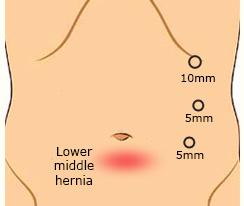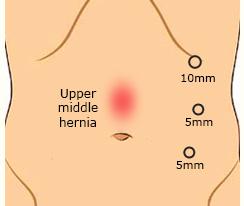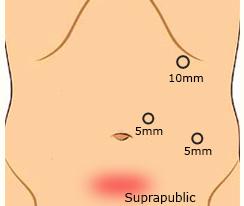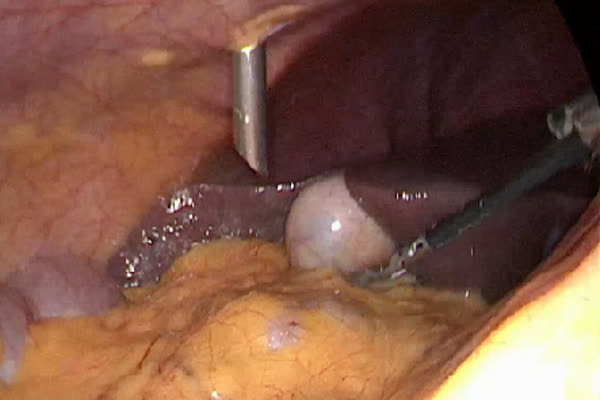Laparoscopic Cholecystectomy Ventral Hernia
Surgeon(s)/Speaker(s): Dr. Lakshmi Kona
Surgical Procedure: Laparoscopic Hernia-Ventral Hernia
Location: Gleneagles Global Hospital Hyderabad
Indexsteps
1. Create pnumoperitonieum : Create pnumoperitonieum using veress needle in the palmers point
2. Port positions : Place one 12mm and two 5mm ports in semi lunar fashion opposite to hernia site at least 5cm away from the hernia deflect
3. Adhesiolysis : Adhesiolysis and reduction of contents
4. Mobilization of bladder : Mobilize bladder for supra pubic and lumbar hernias
5. Placement of mesh fixing : Placement of mesh fixing with trans facial structures and tackers.
port positions
1. Port placement : *In all midline standard ventral hernias, the first port is very important. It may be a blind entry with a veress needle or an open entry but risk of injury to inner structures is high.
*Whether it is umbilical, epigastric or supra/infra umbilical incisional hernias with multiple scars, umbilical 1st port entry is impossible. Ports have to be placed away from all these defects, keeping in mind an overlap of 3-5 cm from all sides.

2. Port placement : *Best 1st entry without any fear is left subcostal region i.e. Palmer point in the left mid clavicular line.
3. Port placement : Ports for Suprapubic hernias
precautionary_measures
1. Handling Bowel : Utmost care while handling bowel, very slow and careful dissection
2. Bowel Injury : On site recognition of bowel injury
3. Energy Source : Minimal or no use of energy source (direct touch of hot tips)
4. Sharp Dissection : Sharp dissection than blunt and pulling force which can produce scrotal (confirm) tears.
5. Adhesions of bowel loops : In case of dense adhesions of bowel loops with peritoneum or old mesh, better to keep a part of the fascia/mesh with bowel
6. Inter bowel adhesions : No inter bowel adhesions should be dissected unless you suspect acute kink or obstruction
7. Bowel perforation : If bowel is perforated / injured early recognition and repair is a must. If spillage of bowel contents or peritoneal soiling occurs, putting a mesh is debatable. Good peritoneal lavage must be done. Composite mesh is postponed or a biological mesh should be used.
8. Bleeding : Once carefully all the adhesions are released (external pressure by assistant over the defect helps in adhesiolysis), sac is visualised for bleeding, control
9. No sac is excised routinely : No sac is excised routinely
10. Part of big sac may be excised : In some cases, part of big sac may be excised to avoid seroma some people may take incisions along the margin of the sac for better mesh adhesions to the wall.
11. Supraumbilical hernia : In supraumbilical hernia, round ligament / fat along the margins is excised for better placement of the mesh
12. Suprapubic hernias : Note: For suprapubic hernias a peritoneal flap is raised subpubically for the placement of distal part of mesh
pre_post_measures
1. Preoperative investigations : Complete blood count:new: Blood sugar – random (fasting and postprandial, if diabetic):new: Serum creatinine:new: Liver function tests:new: Coagulation profile:new: HIV / HbsAg / Anti-HCV (if mandated by hospital):new: Blood group:new: Chest x-ray:new: ECG:new: Echocardiogram (if over 50 years):new: Abdominal ultrasound examination:new:
2. Preoperative measures : Patient is catheterized to empty the Bladder.:new: Attachment of the diathermy plate:new: Securing the patient to the table:new: Padding of the pressure points:new: Dose of prophylactic antibiotic at the time of induction of anaesthesia:new: Anti-embolic stockings / placement of an intermittent compression device on the legs:new:
3. Postoperative measures : NBM for 6 hours:new: Ambulate after that:new: Two dose of Antibiotics:new: Analgesics as required:new:
4. Warning signs in the postoperative period : Careful closure of the fascia at the umbilical trocar site:new: Infiltration of all trocar sites with local anesthetic:new: Closure of wounds and application of dressing:new: Pressure dressing is given on the Inguinal area to reduce Seroma.:new:
Surgical Instruments
1. 10mm Trocar
2. Reducer (10mm to 5 mm)
3. 30 degree 10mm telescope
4. Atraumatic grasper forceps
5. 5mm scissor
